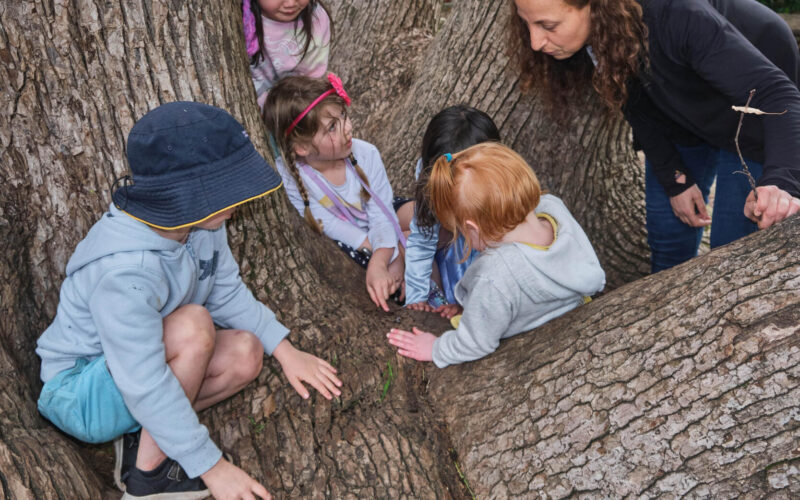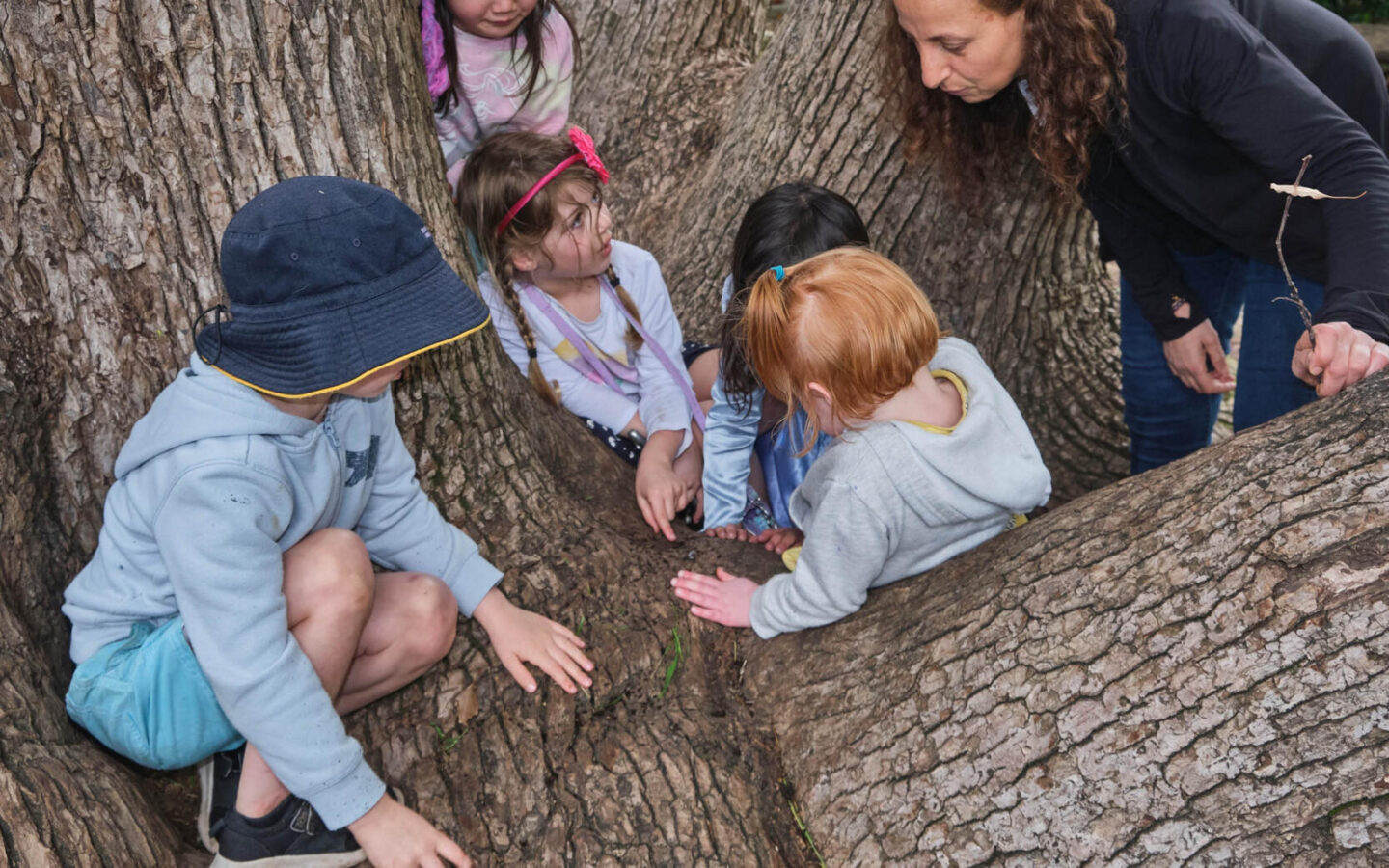

What is ‘nature play’?
Nature play is play that happens primarily outside, in large, natural environments, and/or involves play with natural elements and features. It is open-ended and child-led play, rather than being adult-directed, in which children use their senses and imaginations to interact with natural materials. Natural materials include trees, plants, water, rocks, dirt, mud, sand, logs, leaves and sticks—basically anything non-manufactured that can be found in nature! Nature play allows children to experiment and engage with natural environments and materials and to take the lead in their play experiences as they harness their innate curiosity, creativity and imagination. When immersed in nature play, children drive the ways they interact with natural elements, for example, physically, spiritually, socially or emotionally.
Is there a difference between nature play and outdoor play?
Outdoor play is different to nature play in that it may take place in more urban or suburban outdoor settings and may include some non-natural elements such as paved pathways, fences, or playground or play equipment. Outdoor play also has many benefits for children, and it still provides them with valuable opportunities to engage in unstructured, child-led play and to explore the natural world. Spaces such as backyards, balconies, local playgrounds and even nature strips offer many opportunities for play-based learning.
Why is nature play important for children?
Many children are spending more time indoors, often on screens, or taking part in lots of structured, adult-led activities. However, a growing body of research is highlighting the benefits of nature play for children, particularly during early childhood when their brains are at the most rapid stage of development. Apart from being fun, nature play supports many aspects of children’s learning, development and wellbeing. Here, we explore the key benefits of nature play for young children.
The benefits of nature play include:
- Physical Health and Development
Walking, running, climbing and challenging themselves without adult hindrance helps children to get the exercise they need to develop strong muscles and bones, and may potentially prevent childhood obesity. Interacting physically with natural materials also supports the development of fine and gross motor skills such as balance, dexterity and hand-eye coordination. - Social Skills
When children play together in nature, they have opportunities to develop and practice important social skill such as cooperation, negotiation, shared problem-solving, and empathy as they navigate their play within the natural environment together. It is also more fulfilling and meaningful because the children are in control of the direction and purpose of the play. - Mental Health
Playing in natural environments can reduce stress and anxiety, and increase children’s resilience, confidence and self-esteem. When children play in nature, they leave behind the pressures and distractions of the ‘built world’, making it easier for them to practice mindfulness and to reflect on their thoughts and feelings. - Intellectual Development
Nature play allows children to take charge of their own learning, and to explore, hypothesise, experiment, and problem-solve independently. As the play is child-led, it can make educational concepts more engaging and tangible, helping children understand and absorb information better. When playing in nature, children are also more likely to take risks and to persevere in the face of challenges, enhancing their ability to focus and plan. - Environmental Connection
Children who play in nature develop a deeper connection to the environment. This connection fosters a sense of responsibility and care for the natural world. By exploring and appreciating the beauty of nature, children are more likely to grow into adults who value and protect the environment.
Nature Play Ideas for Home
There are many simple ways to incorporate nature play into everyday life. In addition to the benefits of nature play for children, these activities also create wonderful opportunities for parents and children to connect with each other.
- Take nature walks: Take walks in natural parks, reserves, bushland, or even just on paths in your local neighborhood. Look out for and talk about the natural items and creatures you come across. Tune in to what your child notices, slow down, and allow them time to watch and consider what they see, no matter how small, for example the movement of a snail, the flight of an insect, ants returning to their nest.
- Visit natural spaces in your area: Regular trips to local parks can provide children with the opportunity to explore and play in a natural setting. They are also wonderful places for play dates with other children.
- Unstructured outdoor play: Allow children to play freely in nature, without a structured agenda. Let them use their imaginations to create their own games, adventures and dramatic play.
- Make a mud kitchen: Use old pots, bowls, cooking utensils (or sticks), collect ‘ingredients’ such as water, dirt, rocks, leaves and sand and let your child’s imagination take hold as they ‘cook’ whatever they choose.
- Cloud watch: Go outside to watch the clouds with your child, and talk with them about what they can see, such as the colours and shapes of the clouds, their size and how fast or slow they are moving.
- Watch wildlife: Look for the creatures that you can see in nature, such as birds, insects and worms and talk with your child about what the animals are doing, what they sound like and how they look. Learn together about what these creatures need to survive, and how humans and wildlife can interrelate and co-exist.
- Build items with natural materials: Encourage your child to build structures of their choosing using natural materials outdoors. This might include sandcastles, forts, cubby houses, obstacle courses or pathways. Notice what treasures your child finds while out exploring and support the ideas they have for creating and building.
- Stargaze: Go outside at dusk to watch for when the first star appears, or at night to see and talk about the stars and moon—what they look like, how they move and the shapes the constellations make.
- Weather watch: Encourage your child to notice the weather and how it changes the environment, for example rain creates puddles, cold weather creates frost and foggy breath, hot weather dries out wet things.
Conclusion
Nature play is not just fun for children, it also offers myriad benefits for their learning, development and wellbeing that can have positive lifelong impacts.
References and Further Reading
- Australian Institutes of Family Studies. (n.d.). Engaging young children (0-5 years) in nature play. Retrieved June 27, 2024 from https://aifs.gov.au/resources/practice-guides/engaging-young-children-0-5-years-nature-play
- Goodstart Early Learning. (2020, February 27). The benefits of nature play for children. The First Five Years. https://www.firstfiveyears.org.au/early-learning/the-benefits-of-nature-play-for-children
- Leeane Rough. (2022, November 9). 35 Fun & Easy Nature Play Ideas to Try at Home. Tribe Early Learning. https://www.tribeearlylearning.com.au/35-nature-play-ideas/